Unsure of what Deep Vein Thrombosis consists of? Here’s our guide to the in and outs of this uncomfortable condition.
The risk of DVT – or deep vein thrombosis – is always present when you’re inactive during a long flight or when you’re sitting down during a long road or train journey.
What is DVT?
DVT consists of a blood clot that forms in the leg, which can be potentially fatal if it travels to the lungs and causes a pulmonary embolism (PE). Inactivity is the main cause of the formation of blood clots, as sitting for long periods (four hours or more) reduces circulation in the legs by per cent, which will increase the likelihood of a clot forming.
What are the symptoms?
Only 40 to 50 per cent of people who get DVT will have obvious signs and symptoms, and so the condition often goes unrecognized. When symptoms do occur, they will vary depending on the severity of the condition.
DVT may cause pain and swelling in one or both legs, or less commonly, in an arm. There may also be tenderness in the affected area, and an increase in skin temperature compared to other parts of the body.
Symptoms can include the following:
-
Tenderness in the calf (this is one of the most important signs)
-
Pain in the leg
-
Leg tenderness
-
Swelling of the leg
-
Increased warmth in the leg
-
Redness in the leg
-
Bluish skin discoloration
-
Discomfort when the foot is pulled upward
Who is at risk?
About one in 2,000 passengers on long-distance flights will suffer a blood clot – and the figure is even smaller for passengers on long road or train journeys – so the likelihood that you’ll suffer from DVT is very low. However, the risk may be slightly higher in those over 40 years of age, and is greater in people who:
-
Have had blood clots already.
-
Have a strong family history of blood clots or an inherited clotting tendency.
-
Are suffering from, or have had recent treatment for, cancer.
-
Are being treated for heart failure and circulation problems.
-
Have had recent surgery, especially on the hips or knees.
-
Are pregnant or have had a baby very recently.
-
Are taking the contraceptive pill or are undergoing Hormone Replacement Therapy.














